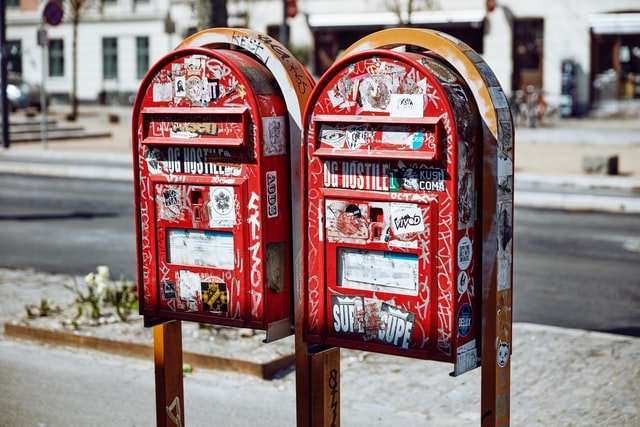Mail Art/Postal Art idea was simple: make work, put it in an envelope, and send it to someone.
It might be conceptual or visual or sound or textual or a combination of various types, as long as it fits in an envelope and wasn’t illegal.
In practice, mail art embraced a wide variety of works produced by thousands of people around the world. Mail art was fun. It was also a way to meet other artists and participate in a community that valued art for its own sake, not as a vehicle for social protest or political propaganda.
There were zines and magazines dedicated to mail art; there were mail art shows and mail art catalogs; there were even mail art festivals. But most of all there were people making work and sending it to other people.”
“mail art” is a broad term for any work of art that is sent through the postal service. Though most mail art works fall into the category of conceptual art, the movement also encompasses traditional fine arts, craftsmanship, or applied arts. The piece may have a visual role, but it also includes a description of the concept behind the work and a statement by the artist.
Mail art (alternatively called postal art, ad-mail art, snail mail art, and artist’s mail) is a form of self-postal artistic expression.
Table of Contents
What is mail art or postal art
What it is: A type of mail art in which a piece of artwork is sent in the mail as a joke, prank, or protest. Mail art or postal art is a kind of artwork that uses the postal service as an artistic medium. It is a form of mail art and of conceptual art. Mail artists create and circulate small, often exquisitely made artworks through the ordinary postal service, without any commercial purpose and without even necessarily knowing who will receive them.
The work may be mailed to anyone, with no return address. It is not necessary that the recipients be artists, although some such as William Powhida have responded by becoming artists themselves. Some mail artists do use their own names, but many use pseudonyms or remain anonymous altogether.
The identity of those who receive the piece is sometimes part of the artwork itself. It can include postcards, envelopes, stamps, and letters. The idea is to send an art piece through the mail rather than mailing something mundane like a letter or package.
As anyone who has ever taken a drawing class knows, it’s hard to draw outside of class because you’re not really sure if it’s any good or not. So what would be cool is if you could send your drawings off into the world and see if they were worth anything or if they were just scribbles.
Why mail art?
Mail art has been around for a while now, though, and it has spawned sub-subcultures that are hard to explain except as extensions of the original idea.
Why would you send someone a handmade object through the mail? Why would you make your own stamps?
The answers to these questions won’t make much sense unless you first see mail art at least as an attempt to solve a particular problem: how can we send things to each other if they won’t fit through our doors? What makes mail art interesting is not what it is but what it attempts to be. What does it mean if you send me something that was made just for me? What does it mean if I send you something that was made just for you? And how do those things relate to what we used to call “art”?
Mail art is subversive because it is both art and mail. If you make an artwork, you are doing something for art’s sake, not to serve any practical purpose. And if you send it through the mail, it is sent on a practical mission, which may or may not be useful. So mail art is constantly straddling the line between the two worlds of art and commerce. If you are not careful, one of those worlds will swallow you up.
I have seen people trying to use mail art as a stepping stone.
They want to gain experience with the postal system so they can move on to using it for more lucrative purposes. But this is a shortcut that can’t work. No one will pay for your expertise in sneaking things through the post office unless what you are sending has substantial value.
So if you are sending mail art, don’t try to pretend that’s just a way station on your path to something more lucrative. It isn’t. It might be worth money someday, but only if it is valuable in itself.
Mail art as an artistic tool
Mail art is an artistic tool. It has no meaning in itself, except as a way of delivering the art that is the point of mail art. If you are just starting out as an artist, or if you are not very successful at being an artist, there are many reasons why mail art might be useful to you.
One reason is that it involves mailing art to strangers, so it can help you overcome your fear of sending your work out into the world where it might be criticized.
Another reason is that it requires handling materials in a way you might not have thought of before, which can give you ideas for new artistic techniques. It also uses materials you may not have had access to before, like rope or rubber stamps or metal.
Most people think of mail art as “art about art” or even “art for artists.” But I think the difference between these two perspectives is largely one of degree. The focus on technique rather than results doesn’t mean you ignore the results. On the contrary, one of your goals will be to figure out how to get better results with less effort. You are still working towards the goal of improving the world, but you are doing it indirectly.
Mail art is a tool for communication and a medium for art. In the context of the traditional culture of letters, two-dimensional mail art may be considered as graphic design, illustration, calligraphy, drawing, painting, printmaking and writing.
In the context of current computer-based communication media such as e-mail and web sites, there are no limits to the number of recipients or dimensions of mail art. Mail art can also be connected with other disciplines such as music (sound poetry), performance, dance, film and video.
When addressing recipients directly through snail mail, mail artists can take advantage of the graphic potential of the postal system to produce stamps as well as envelopes that are works of art themselves.
Mail art as a form of advertising/marketing tool
it’s not surprising that many of the earliest pieces of mail art are advertisements or promotions, or are sent by businesses rather than individuals.
A lot of it still is, but I think there are good reasons for this being so. One reason is that while most people have a fairly accurate idea of what kind of letters they’re likely to get in their mailbox, they have no idea what kind of package might show up. It’s an unusual thing to receive, so it gets their attention.
The best kind of direct marketing works the same way: if you know what to expect, you can filter it out; if you don’t, you can’t. Another reason is that mail art sends a message about the sender. If you get an unexpected piece of mail art in your mailbox, you can assume it came from someone who likes what they do enough to devote some energy to communicating with strangers.
That’s valuable information about them! The same goes for making something yourself and sending it off into the world
The people who sent me all that stuff in the past weren’t trying to sell me anything. They were trying to sell themselves. They wanted to be remembered by someone, anyone; that was enough of a reward. And it worked: they succeeded in getting my attention — but not by making me want to buy their stuff. By making me feel like I got something from them just by knowing them.
Make something interesting to look at
In the early years of mail art, I was struck by how many of the pieces used some kind of visual gimmick. The idea was to make a piece of mail that would be interesting on its own, even if you never opened it. The more I thought about it, the more I became convinced that this rule is a good one.
It’s hard to think of any other reason for making a piece of mail. When you’re not expecting a package in the mail, why do you want to open it? You can consider this rule a kind of law of conservation.
Your envelope has to be interesting enough that if your recipient receives something else in the mail at the same time, he will pick yours out and open it rather than the other one. He’ll quickly get tired of looking at uninteresting mail; perhaps he’ll just toss it into the trash unopened.”
Follow postal rules and regulations
If you want to send a letter or package via the mail, you have to follow certain rules and regulations, which will vary from country to country. All of them are there for a reason.
They are there for your protection, not to annoy you.
To find out about postal rules and regulations in your country, go to the website of your postal service. It should be possible to find detailed information on their FAQ page. If not, try clicking on “Contact us” and then “FAQs.” A good place to start is the postal service’s page for sending letters and packages abroad.
Collaborate with an artist friend
If the point of mail art is to communicate, then that communication can be two-way. You can collaborate with someone.
Collaboration needn’t imply a formal division of labor. It can be as informal as brainstorming, or as structured as taking turns writing paragraphs. The point is that together you are working on something that neither of you would have produced separately.
You might want to work collaboratively because each of you brings something different to the project, and together your efforts are greater than the sum of their parts. Or you might want to work collaboratively for other reasons: because it’s fun, or because it allows you to divide up or spread out the work more easily than if you worked alone.
If you do collaborate, think through what each of you will bring to the project. Are there things one of you could do that would save the other time or effort? Are there ways one of you could help with some aspects that might be harder for the other? Do you both understand what each of you is doing? If it’s a long-term collaboration (e.g., over many mailings), how will decisions be made about whether or not something should be continued?



